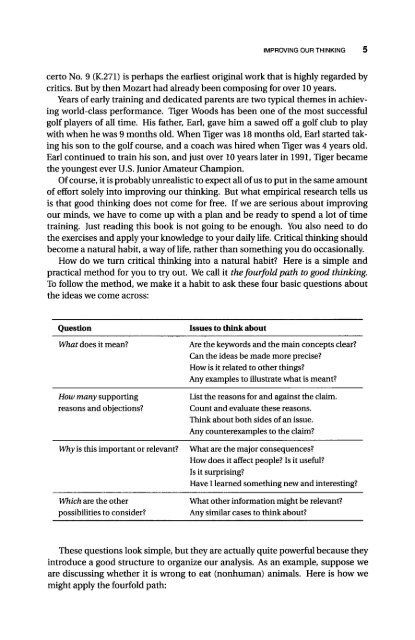An Introduction to Critical Thinking and Creativity - always yours
An Introduction to Critical Thinking and Creativity - always yours
An Introduction to Critical Thinking and Creativity - always yours
You also want an ePaper? Increase the reach of your titles
YUMPU automatically turns print PDFs into web optimized ePapers that Google loves.
IMPROVING OUR THINKING 5<br />
cer<strong>to</strong> No. 9 (K.271) is perhaps the earliest original work that is highly regarded by<br />
critics. But by then Mozart had already been composing for over 10 years.<br />
Years of early training <strong>and</strong> dedicated parents are two typical themes in achieving<br />
world-class performance. Tiger Woods has been one of the most successful<br />
golf players of all time. His father, Earl, gave him a sawed off a golf club <strong>to</strong> play<br />
with when he was 9 months old. When Tiger was 18 months old, Earl started taking<br />
his son <strong>to</strong> the golf course, <strong>and</strong> a coach was hired when Tiger was 4 years old.<br />
Earl continued <strong>to</strong> train his son, <strong>and</strong> just over 10 years later in 1991, Tiger became<br />
the youngest ever U.S. Junior Amateur Champion.<br />
Of course, it is probably unrealistic <strong>to</strong> expect all of us <strong>to</strong> put in the same amount<br />
of effort solely in<strong>to</strong> improving our thinking. But what empirical research tells us<br />
is that good thinking does not come for free. If we are serious about improving<br />
our minds, we have <strong>to</strong> come up with a plan <strong>and</strong> be ready <strong>to</strong> spend a lot of time<br />
training. Just reading this book is not going <strong>to</strong> be enough. You also need <strong>to</strong> do<br />
the exercises <strong>and</strong> apply your knowledge <strong>to</strong> your daily life. <strong>Critical</strong> thinking should<br />
become a natural habit, a way of life, rather than something you do occasionally.<br />
How do we turn critical thinking in<strong>to</strong> a natural habit? Here is a simple <strong>and</strong><br />
practical method for you <strong>to</strong> try out. We call it the fourfold path <strong>to</strong> good thinking.<br />
To follow the method, we make it a habit <strong>to</strong> ask these four basic questions about<br />
the ideas we come across:<br />
Question<br />
What does it mean?<br />
How many supporting<br />
reasons <strong>and</strong> objections?<br />
Why is this important or relevant?<br />
Which are the other<br />
possibilities <strong>to</strong> consider?<br />
Issues <strong>to</strong> think about<br />
Are the keywords <strong>and</strong> the main concepts clear?<br />
Can the ideas be made more precise?<br />
How is it related <strong>to</strong> other things?<br />
<strong>An</strong>y examples <strong>to</strong> illustrate what is meant?<br />
List the reasons for <strong>and</strong> against the claim.<br />
Count <strong>and</strong> evaluate these reasons.<br />
Think about both sides of an issue.<br />
<strong>An</strong>y counterexamples <strong>to</strong> the claim?<br />
What are the major consequences?<br />
How does it affect people? Is it useful?<br />
Is it surprising?<br />
Have I learned something new <strong>and</strong> interesting?<br />
What other information might be relevant?<br />
<strong>An</strong>y similar cases <strong>to</strong> think about?<br />
These questions look simple, but they are actually quite powerful because they<br />
introduce a good structure <strong>to</strong> organize our analysis. As an example, suppose we<br />
are discussing whether it is wrong <strong>to</strong> eat (nonhuman) animals. Here is how we<br />
might apply the fourfold path:
















